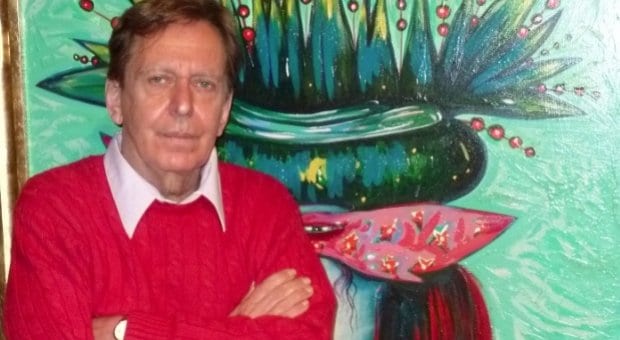Famous names, past and present, fly out of Toller Cranston’s mouth. Picasso, Alice Munro, Marco Polo, Vermeer, Tonya Harding, Catherine de’ Medici, Alec Baldwin, Damien Hirst, Katarina Witt, Henri Rousseau, Naomi Campbell. The list goes on.
Then the Canadian figure skating legend mentions Rob Ford, referring to him as “that adorable, little darling mayor of Toronto that smokes crack. I find him to be odious in the absolute extreme. I hope never to meet him, but I’m not so sure he’s going to fade into the sunset.”
Despite having left Toronto to live and work in Mexico more than two decades ago, Cranston clearly keeps an eye on his home country. He just flew into Calgary Nov 21 to open an exhibition of his artwork, entitled The Museum Collection, and to lecture about “A Terrifying Obsession” at the Art Evolution Gallery and Lounge.
Since winning six consecutive Canadian figure skating championships, from 1971 to 1976, and the bronze medal at both the 1974 World Championships and the 1976 Olympic Winter Games, Cranston has turned his talent to art. Without any formal training, he has been painting productively and successfully for decades. Today he’s well known, perhaps more so outside of Canada, as an artist.
Gallery owner Christopher Talbot, who has represented Cranston for 12 years, compares his work to that of Picasso, Chagall and Van Gogh. He tells the sold-out audience that Cranston financed his competitive skating career by selling his artwork.
In painting as in skating, Cranston is prolific.
A typical day at home in San Miguel de Allende is “quite fantastically productive and boring,” he says.
He describes the paintings filling the Art Evolution Gallery as “the tiniest smidge of what has been done. A quarter of a drop in the bucket.”
Work is “actually all I know,” he confesses. “This is really quite pathetic; I don’t know what to do. I don’t know how to have fun. I wouldn’t know what that meant. I couldn’t. But that said, I’m doing what I want.”
Stylistically, he says, “all my work emanates from the Silk Road. The biggest, biggest, biggest place I want to go to is Uzbekistan. That work is very close to [mine]. Nobody knows the artists, but [it] influences me.”
He’s also influenced by the Italian Renaissance. “I could name all the names, but you probably wouldn’t know them,” he declares, then proceeds to list artists like Fra Filippo Lippi, Fra Angelico, Benozzo Gozzoli and Paolo Uccello. “[They are] early Renaissance, which is more primitive. Not Michelangelo, da Vinci, Raphael.”
“The other thing I like is the one-of-a-kind artist Henri Rousseau, [who] was part of the Impressionist period but not an Impressionist. A naive artist. My work is really rather naïve,” he says.
“That said, I never actually think about anything,” he says. “It just comes out, and that’s the way it is. I could think, but clever people don’t think.”
Cranston, who maintains a connection to skating, is aware of calls to boycott Russia’s upcoming Winter Olympics because of anti-gay legislation the Putin government enacted in June. But he doesn’t think the Games are the best place for political declarations.
“One must be very careful not to incite some international incident with the Games in Sochi,” he says.
“I don’t know if the Olympics is a place to [declare], ‘This is who I am’ and ‘This is what I believe,’” he continues. “Why can’t you just put it on the back burner, or why is it so important? ‘I’m an Olympic ski jumper, but I’m gay and fuck you.’ I don’t see how the two play together. I mean this is little me talking, having done three Olympics.”
When asked about his own sexual identity, he says, “If one can be rather precise, I am married to my work, and that is voluntary. The only thing — the only thing — that’s important to me is working.”
“I once had dinner with Lady Black, Barbara Amiel,” he says, “and actually I’m a big fan of hers, probably not so of Conrad. She was talking about the liberated female or women’s lib, and said she didn’t really believe in that. She believed in the liberated individual, and by the way they’re female. That impressed me because it was about accomplishment.”
“I would be a person from 1920 or [the] turn of the century. I don’t know about contemporary gay life. I really wouldn’t know what it is.”
“If people were to come to my house for dinner,” he says, “it wouldn’t enter my head as to [their] sexual orientation. I wouldn’t know.”
The Bravo channel once came to Mexico for an interview, he recalls. “What they wanted to know was sort of sex, drugs and rock and roll. I basically told the director to ‘fuck off’ and ‘goodbye.’ You’re not getting it. Don’t you see what it is that I do?”
“In our lives, according people respect for who and what they are is very high on the list,” he says. “I would respect everybody — and if anyone is about dancing to the beat of a distant drummer, it’s me. I would understand that clearly, but those personal lives [regarding] sexual orientation [and] behaviour, it’s not interesting to me.”
Toller Cranston: The Museum Collection runs until Fri, Dec 6 at the Art Evolution Gallery and Lounge, 205-1235 26 Avenue SE, Calgary. Search for Art Evolution Gallery & Lounge on Facebook.

 Why you can trust Xtra
Why you can trust Xtra


